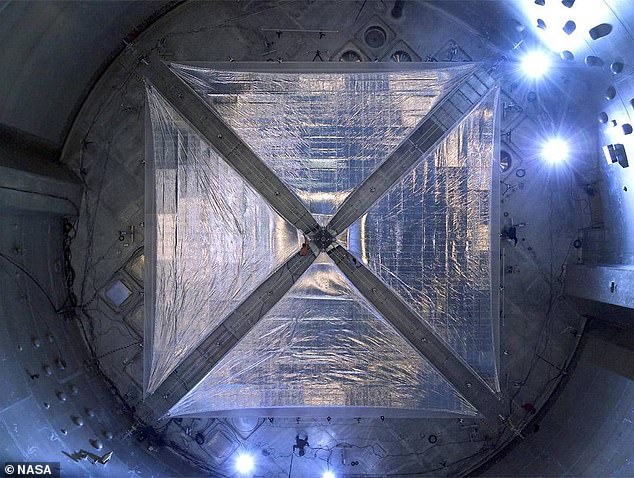NASA’s new $20 million spaceship hurtles through space uncontrollably after malfunctioning
A new NASA spaceship is tumbling uncontrollably through space as engineers on the ground try to fix a problem that caused the $20 million spacecraft to lose control.
The agency’s Advanced Composite Solar Sail System (ACS3), a vessel with four reflective ‘sails’ designed to test a new type of propulsion system, encountered a problem when it deployed the sails.
Engineers noticed a slight bend in one of the ‘booms’, or structural beams, that support the sails, affecting its ability to stay on course.
NASA has kept ACS3’s attitude control system – which controls a spacecraft’s orientation – disabled. Engineers are assessing this damage.
As a result, the microwave-sized spacecraft is currently making its way through space.
This mission is a test of new space technology uses the pressure of sunlight for propulsion, similar to the way a sailboat is powered by the wind.
One day it would be the extremely high cost of deep space missions. But first NASA will have to battle its runaway craft.
The Advanced Composite Solar Sail System (ACS3) is a microwave-sized spacecraft equipped with four reflective ‘sails’ designed to test a new type of propulsion system
ACS3 launched from New Zealand on April 23 aboard Rocket Lab’s Electron rocket.
Just a few months after launch, the spacecraft’s sail jammed when an onboard power monitor detected higher-than-expected motor currents and paused the deployment process.
In late August, NASA successfully deployed the sails on a second attempt.
But before doing so, engineers disabled the spacecraft’s attitude control system to accommodate dynamic changes as the sails unfolded. It has since been disabled.
Now the discovery of this bend in one of the booms has further delayed the reactivation of the attitude control system while engineers work to assess the damage.
“This likely occurred when the booms and sail were pulled tight against the spacecraft during deployment,” NASA’s update said.
‘Analysis indicates that the bend may have been partially straightened over the weeks since the boom deployment as the spacecraft was slowly tumbling.’
Engineers are currently working to reposition the spacecraft, keeping it in “low power mode” until the sails are pointed toward direct sunlight.

This system uses sails powered by the pressure of sunlight for propulsion, similar to the way a sailboat is powered by the wind.
Once the team reaches that desired position, they can re-enable the attitude control system and stop the spacecraft’s continued tumbling.
At that point, the reoriented spacecraft will be able to point its radio antenna at mission control on Earth and communicate with NASA engineers on the ground.
This allows engineers to collect even more data, calibrate the precise shape of the sail and prepare for the sailing maneuvers, NASA said.
The sailing maneuvers will be the true test of this new propulsion system.
Engineers will angle the sails to change the spacecraft’s trajectory, which is crucial to their ability to maneuver ACS3.
It is currently about 900 kilometers above the Earth’s surface – twice as high as the International Space Station.
Once the spacecraft entered a sun-synchronous orbit — which allows a satellite to stay in sync with the sun as it orbits Earth — NASA engineers turned off the attitude control system and deployed the sails.
The ACS3 mission is designed to test solar propulsion as a way to reduce the costs of deep space missions, such as flights to Mars.
The spacecraft’s four sails unfold to form a 30-foot-wide silver square supported by two diagonal booms.
When light particles (or photons) from the sun collide with these sails, it creates small angular momentum that propels the spacecraft, much like a sailboat.
The force exerted by sunlight is approximately equal to the weight of a paperclip resting on your palm, according to NASA, just enough to allow the spacecraft to overcome atmospheric drag and gain altitude.
NASA isn’t the first to test a solar-powered propulsion system in space.
The Planetary Society’s LightSail 2 launched in 2019, reaching an altitude of two miles two weeks after deploying its 3,000-square-foot sail.
But the mission ended in disaster when the spacecraft began to lose altitude and eventually burned up in Earth’s atmosphere.
LightSail 2 inspired the ACS3 mission. If NASA can prove this technology works, it could significantly reduce the amount of fuel needed for space missions, saving the agency a lot of money.
“The data collected during this flight test has already proven highly valuable, and the demonstration will continue to produce critical information to enable future solar sail missions,” the agency wrote in a recent update.
